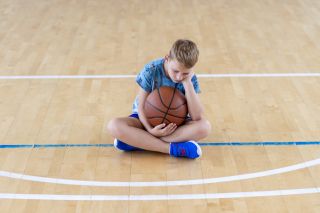Sport and Competition
Where Are All the Average Child Athletes?
Where do children go to play sports when they're just "average"—or worse?
Posted July 23, 2024 Reviewed by Devon Frye
Key points
- Our aggrandizement of athletic prowess discourages kids from staying with activities unless they excel.
- Too many kids drop out of favored activities once they discover that they’re not all that special.
- What if we champion the idea that enjoying an activity is more important that being good at it?

You don’t see them anymore. They’ve been run out of the community rec leagues, the middle school teams, and the summer camp clinics. For the most part, they’re at home, playing video games.
How’d we get here? I often ask myself—here, where if you’re not suited up by the age of six, you might as well forget about ever picking up a new sport. But I exaggerate, of course. Or maybe not.
Anyone familiar with youth sports knows that the lines of demarcation between athletic and nonathletic kids are drawn early on. Those nonathletic kids who do play on teams are often agonizingly unvalued as players and dismissed by coaches and peers alike. Once marginalized as "bad athletes," they often drop out of the sport altogether and likely never pick it up again.
Who are these "bad athletes"? Some are kids who simply lack a natural athletic ability; their talents or interests lay elsewhere. Others might be kids with indiscernible developmental disorders or other motor deficits that affect coordination and sensory processing. These kids often have trouble catching and holding balls, or throwing objects based on what their eyes are seeing. Their gait may be awkward or slow; they are the kids who are always tagged “it.”
There are also some learning disabilities that result in processing deficits affecting a kid’s ability to play sports. Visual processing deficits make it difficult to throw balls into hoops or hit them with bats. Visual-motor deficits mean that kids will have problems with activities involving steering or aiming. Kids with spatial deficits have trouble staying within bounds and tracking moving objects. They’re the poor kids who run in the wrong direction on the field once they catch the ball.
I’m a psychologist who sees kids and teenagers. I often ask them, "What did you used to like to do, but don’t do anymore?" The answers are varied—volleyball, softball, soccer, flute, dance, gymnastics—but their reasons for stopping are usually the same: "I wasn’t any good at it.” With the younger kids especially, I gently ask, "But what does that have to do with whether or not you still do it?” The kids look at me as if I’m demented. The looks I get from parents are worse.
I'm not an idiot. I am aware that people generally like doing things they’re good at, and drop things they’re not so good at. It makes sense—if we’re talking about older kids, teens, or adults who have had multiple opportunities to explore their interests and talents and are focusing on those they wish to make the most of. But young kids?
With such abbreviated—not to mention hypercritical—windows of opportunity for exploring sports during the grade school years, it’s no wonder so many kids bail preemptively, that is, before they become that kid who no one passes to. How long is “too long” for a nine-year-old to become a good enough player?
Alternatively—and maybe controversially—what if we champion the idea that being good at an activity is not necessarily a requirement for participating in it? I’m not talking about competitive school teams here, or travel teams; I’m talking about community rec leagues, elementary school intramurals. I had thought they were a place where kids could go to learn a sport. Apparently not. Or not anymore.
There are unintended consequences to worry about, too, when we put such an emphasis on physical prowess so early on. Kids learn all the wrong things from our precocious aggrandizement of athleticism, e.g., that stronger, faster, or mightier is always better, that these traits bear the standard for all things masculine, and that boys who are less athletic or less aggressive or less competitive by nature are simply less than. These ideas continue to fuel the pernicious culture of jock domination in schools, where athletes repeatedly exploit their social capital and the myriad accommodations made for them by school personnel.
My point is that over time, athletically gifted kids will have plenty of opportunities to demonstrate their skill level and advance in their sport of choice. They don’t have to be picked out of the lineup right out of the gate. That little bit of reserve would give their less-endowed peers a chance to see if they wanted to put in the effort to compensate for their shortcomings and stay in the game, or play simply because they like the game—hardly a crime.
More important is the opportunity for kids to be mentored by a greater number of coaches and parents who will support expanding the margins of "acceptable" play in rec leagues and camps, and choose to prioritize inclusiveness and fraternity over the mastery and execution of sports-related skills. To what end is that? To the end of raising bigger and better human beings, whom we need more than bigger and better athletes.




